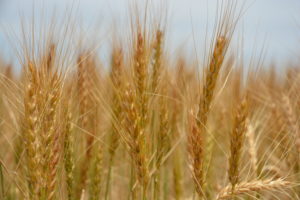Amarillo, Texas, USA
December 5, 2014
Plant growth regulators are nothing new for cotton farmers, but they are of recent interest to some wheat producers who are questioning their efficiency and economics, said Dr. Jourdan Bell, Texas A&M AgriLife Extension Service agronomist in Amarillo.

Producers question whether plant growth regulators have a place on the High Plains for wheat. (Texas A&M AgriLife Communications photo by Kay Ledbetter)
Bell, speaking at the recent Focus on Wheat meeting during the Amarillo Farm and Ranch Show, said plant growth regulators have been used on wheat in Europe for some time.
There was some interest in the High Plains on plant growth regulators in wheat production in the early 80’s, but due to production limitations, producer interest quickly faded, she said. With newer, improved products, local interest has increased.
“First, if a producer were to use them, we would only be talking about irrigated grain-only production of wheat where it might play a role,” she said.
“At this time, I can’t say yes or no, but it is a matter of economics,” Bell said.
In wheat, as in cotton, there are many environmental and product interactions that come into play, she said. Plant growth regulators are natural and synthetic hormones, and it is critical that application timing takes place to enhance those interactions and not interfere.
Bell said research in other regions has shown putting on the plant growth regulators at the wrong time during the grain-filling period can actually limit yield.However, if applied according to the label, manufacturers claim both reduced lodging and often a yield boost.
“Right now, we are in need of local data to determine if some of the claims hold up in our environment,” Bell said, adding she will be conducting a plant growth regulator trial in Castro County this spring.
The primary reason a producer would want to use the product is to control lodging, she said. The thought is the plant growth regulators would control the height and the strength of the stalk, which can be regulated by the hormones.
“My question is: Do you really need a PGR or should a producer consider wheat variety, other inputs and agronomic management? Cultivar selection, planting dates, excessive nitrogen and excessive irrigation are all factors that come into play with lodging. While freeze damage and disease can also result in lodging, it may not always be economical to use a PGR to minimize damage from unplanned events.”
Bell said the producers who have been inquiring about plant growth regulators are concerned about late-season lodging. While late-season lodging causes many harvest challenges, the biggest lodging yield losses occur when the head is emerging.
“Again, irrigation, or excessive irrigation and irrigation timing, are important factors in lodging,” she said. “But with our water district restrictions, producers are trying to be strategic in their irrigation applications. They need enough water for their wheat crop, but if a producer plans to double crop, they also need to have enough water to carry them through the summer.
“So, excessive irrigation in wheat production is generally not a problem in this area.”
Another thought, Bell said, is while producers want to put more water on the crop to maximize the yield, their greater concern should be maximizing revenue.
“With lower commodity prices, producers are evaluating the costs of all inputs,including irrigation costs. As producers make decisions to maximize the revenue, they may not really need a PGR. That is another added cost,” she said.
“And more importantly, producers need to know they cannot stop an impending disaster from happening by applying a PGR right before a freeze, hoping to keep the stalks strong and the wheat from lodging.”
Bell said because of the limited information applicable to this region, producers should be cautious about the use of plant growth regulators.
“If you are going to do it, leave 5 or 10 acres out and see if you really see a yield boost,” she said. “Determine if the difference is because all the inputs were just right or if the PGR made the difference.”
In the end, Bell said, plant growth regulators in this region might have more application in other crops such as triticale and barley, both of which are more prone to lodging.